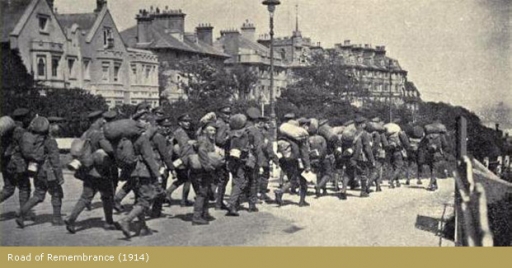The southern English town of Folkestone was the port of departure for millions of British and Commonwealth troops during the First World War.
From camps nearby and from its railway stations they would march down Slope Road, today re-named the Road of Remembrance, to the harbour and thence to the Western Front.
Weighed down with rifle, helmet and kit, soldiers were given the order to ‘step short’ as they negotiated the gradient.
That command has today been adopted by a local charity dedicated to marking the town’s role in the First World War and providing insights into the lives of those who passed through it on their way to the battlegrounds of France and Belgium.
Step Short director Michael George says: ‘We have various projects planned, the biggest of which is an arch we’re hoping to build on the Leas [a famous open space above the cliffs] in Folkestone. Our aim is for this to be an iconic, interactive memorial at the top of the Road of Remembrance.’
Another project under discussion is a bas relief of 10 soldiers marching, which could be erected by the side of the Road of Remembrance. The possible size of this is still a subject for debate, but it could be in the region of 30ft in length.
Step Short is increasingly active in the local community, George adds: ‘We’re a registered charity and one of our charitable objectives is education. For example, Folkestone and nearby Shorncliffe were the primary bases for the Canadian Expeditionary Force and tens of thousands of Canadians were based here before they went to the Western Front.
‘A number died from wounds and others in air raids and there are more than 300 Canadians buried in the CWGC cemetery in Shorncliffe. Every year local schoolchildren mark Canada Day by placing flowers on the graves of Canadian soldiers. We’ve been working with the schools to help provide some background and to tell the stories of some of those men.’
Step Short is also intending to focus attention on Folkestone’s role in the First World War through a number of guided walks and re-enactments. The first of these is scheduled for 9 June 2013 and will be centred on places that were particularly important during the 1914-18 period.
George says: ‘There were two large hotels on the Leas; the Metropole and the Grand. Today, these are flats, but during the First World War they were used as accommodation for officers – Wilfred Owen stayed on two or three occasions – and also as a training base for members of the Women’s Auxiliary Army Corps (WAACs) who were on their way to France. More than 7,000 of them passed through the Metropole during the war.’
‘Further along the Leas was the Manor House Hospital – now the manor house apartments – where many British and Commonwealth soldiers were treated. We have a fabulous album kept by one of the nurses there. She got some of the troops to write down bits of verse, draw pictures and there are lots of photos in it as well.
‘By Clifton Crescent there was a massive rest camp for troops who were about to embark for France and military bands would play on the bandstand that is still there on the Leas.’
In cooperation with Folkestone School for Girls and the re-enactors of the Queen’s Own Royal West Kent Regiment, Step Short will be providing insights into what happened at all these locations.
Adds George: ‘Outside the Metropole we’ll have some of the girls dressed as WAACs. They’ll be learning the kind of things that would have been taught to the women volunteers during the First World War – how to drill, drive and fix car engines, for example.
‘We’re going to recreate the rest camp; which provided a kind of home from home for soldiers, with a canteen and somewhere to play games such as skittles, cards and bagatelle. We’re hoping to bring back something of the atmosphere it would have had – a little oasis for the men before they went off to God knows what. We want to recall something of what they might have been feeling and what people would have been doing to help them get through that time.’
At the other end of the spectrum, girls in period costume will be handing out white feathers – a symbol of cowardice that was given to young men seen to be shirking their duty.
‘That movement was started in Folkestone by a retired admiral called Charles Penrose Fitzgerald,’ says George. ‘It soon became very controversial, with the government issuing a badge that could be worn by men who were engaged in war work, but weren’t in uniform.’
Other projects include the possible transformation of Folkestone’s tourist information office into a fully functioning education centre with special reference to the First World War and the exploration of 1914-18-era ship wrecks, including those of several German U-Boats – in conjunction with the local scuba club.
George adds: ‘We realised we were focused on lots of land-based ideas, but the trip over the Channel was also very important, not only because it was the way so many were fed into the Western Front, but also because, of all those millions who made the crossing, not a single soldier was lost to enemy action, thanks to the Royal Navy and the static defences in the area.’
To find out more about Step Short, visit the website here.
Images courtesy of the Step Short website.
© Centenary Digital Ltd & Author
